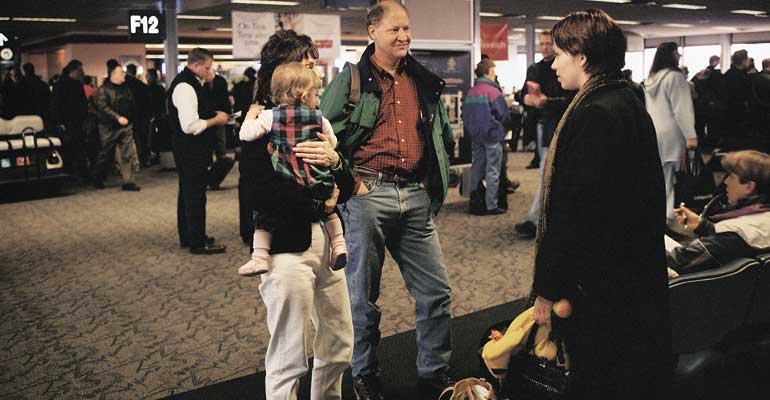When California residents Kim and Carl Felder adopted their son, Robbie, they got to know his birth mother, Tony, very well. The relationship grew so close, in fact, that Tony lived with the Felders for a while before Robbie was born.
But when Robbie was about three years old, Kim recalls, “Tony literally disappeared. And it just about crushed me.” Kim wondered where Tony was and whether she was alright.
Robbie, too, wondered aloud why his birth mother didn’t call or write. Tony did resurface a few years later, and Robbie spoke to her on the phone. He asked her to write, but no letter ever came.
[Free Webinar: Openness in Adoption—From Fearful to Fearless]
“The sad part was that Tony didn’t follow through,” Kim says. “Every day we went to the mailbox.”
Eventually, she had to put her arms around her then seven-year-old son and explain that some things were hard for Tony to do, that this was why she looked to Kim and Carl to be his “everyday” parents. “He cried and cried, and it was very sad,” she said. “But that is the reality of our life.”
The empty mailbox is just one example of the challenges that families in open adoptions may face. In recent years, we have embraced the concept of open adoption with gusto — yet the journey, for some, has proved to be unexpectedly bumpy. Lack of support, a sudden change in the life of either the adoptive or biological family, logistical pressures — all can complicate matters. Add to that the emotionally charged issues at stake-parenthood, power, identity — and open adoption can make for some combustible family dynamics.
To be sure, open adoption gets rave reviews from the many social workers and families who champion it. Since the mid-1970s, open adoptions have been widely accepted as more compassionate and enlightened than the secretive adoptions of a previous generation. Indeed, the confidentiality that once defined adoption is no longer the norm. While international adoptions remain mostly closed, as do many public agency adoptions, domestic adoptions increasingly involve contact between adoptive parents and birth parents.
The good news is that recent research debunks many of the myths that once stigmatized openness. Children in open adoptions have no confusion as to who their parents are, and birth mothers do not have trouble moving on.
[10 Ways to Build Trust with Prospective Birth Parents]
If anything, openness appears to help kids understand adoption; relieve the fears of adoptive parents; and help birth mothers resolve their grief, according to researchers Harold D. Grotevant and Ruth G. McRoy. “Many of the fears about open adoption do not seem to be a problem,” said Grotevant, a professor at the University of Minnesota and co-author with McRoy of Openness in Adoption: Exploring Family Connections.
Grotevant, however, sounded a note of caution to those who portray it as a panacea. The children of open adoption do not have higher self-esteem than those in closed adoptions, he observed. For children in each group, self-esteem is about the same, his research found. He stressed that more research is needed to assess the impact of open adoption on adolescents. (The research he did with McRoy studies children up to age 12.)
Degrees of Openness
For many families, open adoption remains controversial and misunderstood. Even among experts, definitions of “open adoption” vary wildly. In its simplest sense, an open adoption is one in which the adopting parents and the birth mother (and possibly the birth father) have some form of contact, directly or through an agency or lawyer.
At one extreme are the families who exchange letters and pictures but have never met. At the other are the children whose adoptive and birth families socialize at least once a month or more.
[Free Download: Infertility and Adoption Guide]
Most open adoptions lie somewhere in the middle, according to Grotevant and McRoy, exchanging letters, pictures, and phone calls, and having face-to-face meetings once or twice a year. Whatever their situation, many families report that relatives and friends condemn openness, and voice fears that the arrangement will make the birth parent want the child back.
“The challenge we have is getting the media and people outside our immediate family to understand that open adoption is the best choice we’ve ever made,” said Jill Dillon, a resident of southern Oregon, whose daughter, Carly, is eight years old. “We feel that it’s a healthy, safe way for our child to grow up, knowing her birth family and her ‘real’ family, as we think of ourselves.”
Carly’s father, Doyle, knows about closed adoption firsthand: he was adopted and didn’t find his birth parents until he was 33. “He certainly wanted Carly to know more about her background than he did,” said Jill.
Carly talks on the phone with her birth mother, exchanges pictures and letters, and sees her about three or four times a year. She has also had several visits with her birth father. Last summer, Carly was a flower girl in her birth mother’s wedding.
Challenges for Children
For children in open adoptions, the toughest challenge may come when a birth parent who’s been visiting or calling suddenly vanishes or drifts away. The trigger can be a move to a new job, a marriage, or a personal problem, such as drugs or alcohol. In some cases, a birth mother may not feel worthy of contact, or she may get the message from the adoptive parents that she’s not welcome.
Laura Miller, of Long Beach, California, was committed to an open adoption for her now 13-year-old son, in part because she had seen her adopted brother suffer from lack of knowledge. But Miller has had to work hard to keep her son’s birth mother in their lives.
“Although I’m very open, [his birth mother] drops into and out of our lives as she needs to,” Miller said. After one long absence, when her son was nine years old, she paid for his birth mother to fly from Colorado to California and stay with them for ten days. Miller doesn’t give up, she said, “because I think we need to honor the pieces that we didn’t provide in the makeup of the child.”
Experts say that some social workers initially pushed open adoption as a benefit to birth mothers. This turned out to be a mistake.
“A lot of birth parents went into it thinking it was a privilege to them,” said Brenda Romanchik, executive director of Insight: Open Adoption Resources and Support, an adoption education and support organization in Royal Oak, Michigan. “So when things got tough, they thought, this isn’t working for me, so I’m going to leave. They didn’t take the child into account.”
Occasionally birth parents experiencing shame or sadness just have to retreat for a while. In rare cases, when safety is an issue, adoptive families may have to cut off contact. A child whose biological parent disappears experiences a double whammy. He wonders why he was placed to begin with, then feels rejected again because a birth mother no longer visits.
“Children occasionally have some pain when the birth parents opt out,” acknowledged Sharon Kaplan Roszia, who, with Lois Melina, authored The Open Adoption Experience. “I have to remind parents when that happens, that, as long as their door is open, they are practicing open adoption.”
Adoptive families who have lost touch with a birth parent should establish contact with other members of the child’s biological family if they can, such as birth grandparents, Roszia suggested.
In the early days of open adoption, Roszia noted, the conventional wisdom was that adoptive parents would be the ones to drift away. That has not turned out to be the case. “I think the people who have disappeared most often have been the families of origin.” she said.
Roszia and other professionals advise families to be flexible, to recognize that all family relationships change over time. What worked for a child at infancy may not work when that child starts school or enters the middle years.
“When kids begin to understand reproduction, they may become sad to realize that their adoptive mother is not the one who gave birth to them,” said Romanchik. It’s important for adoptive parents to validate those feelings, she noted, without anxiety that they are somehow betraying the birth mother.
Parents may also wonder how to react when kids start voicing their preferences regarding birth parent contact. Letting a young child call the shots in an open adoption is probably a bad idea. (After all, small children don’t get to decide when to visit grandparents or other relatives.) But a child of 12 may be ready to make some decisions about whether or when to meet with birth parents. “The older a child gets, the larger the role they should have,” Grotevant advised.
Things can also get tricky if a child’s adoptive and biological parents have different values or expectations. Karen Chavoie had to bite her tongue recently when her 13-year-old daughter, Kendall, came back from a shopping trip with her birth mother, Stefani.
“Some of the things they came back with, I really didn’t agree with,” said Chavoie, who lives in Portland, Oregon. “I felt they were a bit too grown-up for Kendall.”
A generation gap played a role. Chavoie is 47, her husband, Rob Holliday, is 45, while Stefani is 28. (She gave birth to Kendall at age 15.) As do many adoptive parents, Chavoie and Holliday took on something of a parental role with their daughter’s birth mother. This was not always easy, Chavoie acknowledged.
“If you have a certain amount of closeness with your child’s birth parents, you’re going to fall into their lives,” Chavoie said. “And it becomes a matter of stepping back and letting them make their choices.”
If adoptive parents end up “parenting” a birth mother, too, she may eventually push them away, and this could hurt the child. Conversely, it may not be appropriate for adoptive parents to confide to a birth mother about how their child is grappling with adoption.
Putting the Children First
Most importantly, experts say, biological and adoptive parents must remember that open adoption is about meeting the needs of children, not adults. Openness does not simply wipe away the feelings of grief, fear, or insecurity that can swirl around an adoptive placement.
“It removes the mystery, but it doesn’t remove the grief,” said Claude Riedel, a psychologist and family therapist who co-directs the Adoptive Family Counseling Center in Minnesota. “The reality is that, at certain stages, it’s normal to have questions: why did you choose not to parent me, not to keep me? And there may be complexities: have you kept your other children, but not me?”
Now that the first open-adoption generation is under way, social workers are becoming more aware of the role of siblings in these arrangements. An adoptive child’s relationships with biological siblings need to be taken into account. And two children adopted into the same family may have different degrees of openness with their birth mothers. Openness may also affect decisions about family size.
Sue and Dean Heinzman, who live in Maryland, are huge fans of their son’s birth mother, Carly. The Heinzmans and their son, Ben, now three, socialize regularly with Carly and her extended family. Yet that very closeness has made a second domestic adoption seem daunting to them.
“I couldn’t be involved with another family,” Sue says. “I just can’t add umpteen more people in my life.” At the same time, the Heinzmans are thrilled to have hit it off so well with their son’s birth mother. “I love this open adoption,” she said. “I love Carly.”
Sue Heinzman’s enthusiasm for openness was echoed by virtually every family interviewed for this story. Even Kim Felder, whose empty mailbox made her son so sad, would not have it any other way. Robbie is one of four children adopted by the Felders since 1987, all of them involved some form of openness. And Kim knows the pain of closed adoption firsthand: she placed her son, Jim, for adoption 24 years ago, reuniting with him when he was 18.
“My kids are of all different races and religious backgrounds, and it has been awesome to have that resource in our family,” said Kim. “It gives them a sense of their history, their ethnicity, and of who they are.”


